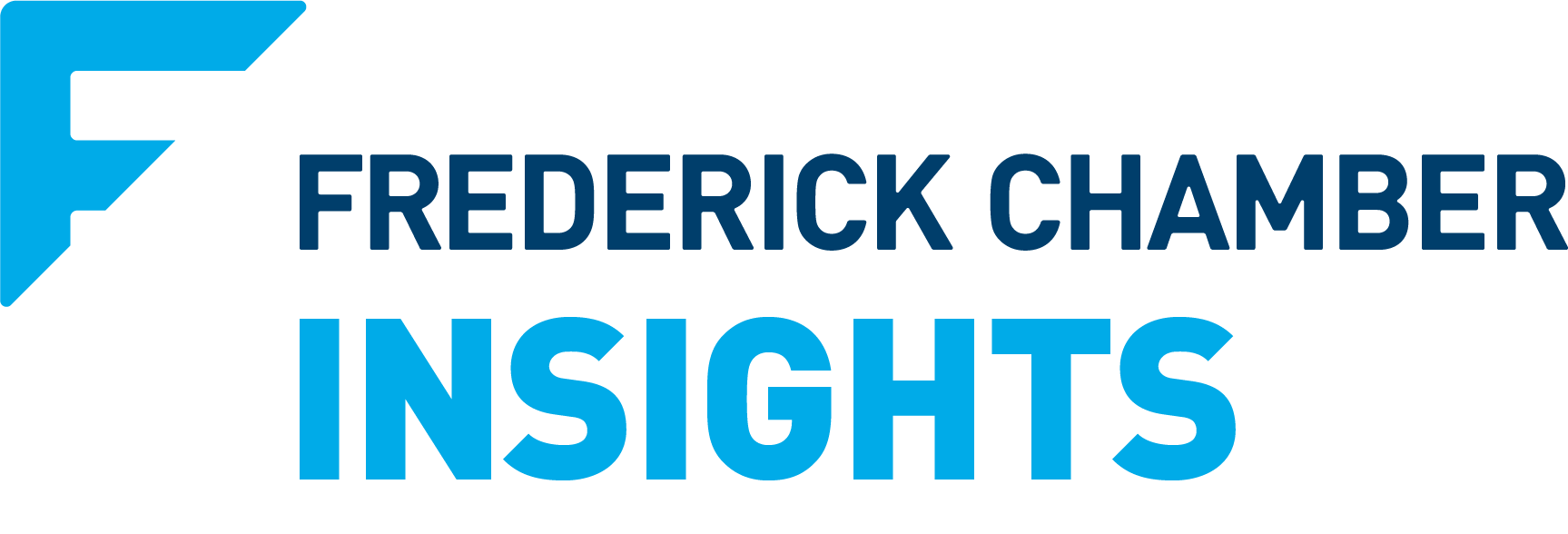Don’t get eaten by your competition. See what I did there? I’ve been reading and talking about E-A-T quite a bit lately.
I recently did a webinar on Google E-A-T for the Frederick County Chamber of Commerce and decided I would share that information with the entire Chamber membership as well.
In case you’ve been under a rock or watching too much CNN… Here is a definition from future Wellspring Digital Chat guest, Roger Montti…
“E-A-T is an acronym for Expertise, Authoritativeness, and Trustworthiness. Google created E-A-T for measuring the quality of content, particularly for third-party raters (QRG)” Roger Montti, Owner of Martinibuster.com
Quick E-A-T Facts
E-A-T is mentioned 137 times in the Quality Raters Guide. This is a guide updated regularly that serves as the handbook for the 10,000+ raters who assess whether or not Google’s SERPs (search engine results pages) are delivering quality links and information.
E-A-T is NOT an algorithm or ranking factor and is not directly measurable. The raters use E-A-T as a guide and the ratings they report back to Google inform any future algorithm changes.
So, in a way, E-A-T is more important than the current ranking factors and algorithms because it signals the future of those factors and algorithms. E-A-T is future-proofing your online presence.
Google Core Update and the Product Review Update have primarily been about E-A-T in one way or another. These updates could be considered the offspring of the Panda and Penguin algorithm updates.
Panda was content-related in that it focused on eliminating thin and/or duplicate content from the SERPs. Penguin was link-related in that it punished websites for having poor quality links pointing to them.
Each subsequent core algorithm update always mentions E-A-T. In other words, Google is continuously stressing the importance of your website’s expertise, authoritativeness, and trustworthiness.
E-A-T is not in and of itself a ranking factor but rather a framework that encompasses the many signals Google uses to evaluate and rank great content.” Lily Ray, Senior Director, SEO at Amsive Digital, E-A-T Expert and Advocate
E-A-T Friendly Content Marketing and Link Building
Content marketing is a very old practice that seems to get a makeover each year. There is always some new and exciting way to create content and get it out there to build links.
The bottom line, though, has always been that the quality and utility of your content were the top priority. Sure, you can rush your content so you’re publishing new stuff every five minutes, but the quality ends up being so poor that it costs you in the long run.
I love this quote from a recent Search Engine Journal article by Alex Valencia…
“You can’t fake your website’s E-A-T, and you can’t trick Google into thinking you have it when you don’t.” Alex Valencia, Co-owner of We Do Web Content
Instead of focusing on quantity, take a step back and reassess the quality of your content marketing and the links it builds.
Expertise in Your Content Marketing
People rely on experts for just about everything. The products and services you offer are not exempt from that fact.
Google E-A-T dictates that you should use subject matter experts writing to their expertise level. This expertise is shown on the byline or author page.
Expert content is also highly researched content with verified facts. And it is clearly edited, reviewed (regularly), and publicly vetted. While blog posts can be great sources of expert content, case studies, white papers, and fact-rich reports are also a great way to really show off your expertise in a way that benefits the reader.
Also, be diverse with your content offerings in their types and subject matter. Experts will consistently offer unique analyses and perspectives.
Author Page Tips
Your author pages should almost be mini-websites where you celebrate the expertise of the author. This is how you showcase that your organization is run by proven experts.
On these pages and even in their bylines, showcase external links where they’ve been quoted or cited as a resource and also where they’ve published E-A-T content on E-A-T websites.
And include links to articles they’ve contributed to your website and blog, including videos, podcasts, images, speaking gigs, etc. You can also include the tools and software they are proficient in.
And make sure that if they are guest posting on other sites, to include lots of bio detail for those bylines and author pages. And be certain to sync content with schema data, and check the Knowledge Graph to see how they show up for name searchers.
More on the schema and the knowledge panels in a second.
Authority in Your Content Marketing
Build proof outside of the website with mentions and backlinks from authoritative sources. These are called “vectors” of proof. In other words, these trusted websites tell Google, “Hey, we think this person and website are worth checking out.”
You can shout from the rooftops about how much you know, how great you are, and all the accolades you’ve received, but until Google sees verified proof from other sources, they won’t buy it.
Here are some surefire ways to build these vectors of proof…
- Contribute thoughtful, unique, and useful guest posts on sites with high authority.
- Become a citation on high E-A-T sites by producing and sharing facts in things like infographics, charts, and graphs that people can reuse with attribution.
- Encourage others to cite your content. This one can take some time but there is a big payoff. Seek out popular blogs where it would make sense for them to link back to you and simply ask for the link.
- Seek out interview opportunities on podcasts and in industry blogs.
- If you have newsworthy announcements, write a release and put it out on the wire with links back to your site or an appropriate page on your website.
- Be a useful participant in forums like Quora.
- Make sure your backlink profile supports your E-A-T. Disavow any links from less than reputable sources to make sure all of your vectors are vectors of proof.
Authority for your website and your experts comes from proof. Actively work to build up those vectors of proof and you will see growth with your SEO campaign.
Trust in Your Content Marketing
Earn trust, that’s the only way it exists. If someone you don’t know says “trust me,” do you? If you do, we need to talk. I doubt you do.
Trust comes from proving you are trustworthy and from others vouching for you. Trust takes time and to keep it, you need to stay consistently trustworthy.
The best ways to earn and keep trust online are to…
- Encourage reviews of your website, company, and content authors on platforms like Google and Yelp, where it makes sense. You can also build a solid profile on platforms like LinkedIn, Crunchbase, and Clutch.
- Use citations in your content and schema. Back up the facts and claims that you make in your content so people view you as a credible source.
- Host a safe and secure website. Make sure you have an SSL certificate. Like now!
- Make contacting you EASY! I am amazed at how many websites hide their contact information. Don’t do this. Be transparent and easy to contact.
- Use badges and seals like BBB or Verisign.
- Think and write like a trusted journalist, where citing your sources matters.
Work diligently to become a trustworthy brand searched for by name! In an era of “fake news,” it is supremely important to have content that is “verified” in a visible and legitimate way.
“E-A-T: Google’s criteria for analyzing the trustworthiness of content – and the people who publish it – in order to mitigate the spread of misinformation.” Lily Ray, Senior Director, SEO at Amsive Digital, E-A-T Expert and Advocate
The more ways you can verify your content marketing, the more trusted you will be.
Link Building The E-A-T Way
Link building is still very important. Links, as stated above, are the vectors of proof that Google is looking for when they crawl and rank your website. Backlinks are also how people and Google find your website.
Here are some labor-intensive but incredibly valuable ways to build your vectors of proof…
- Don’t sleep on HARO. HARO is a tedious but highly rewarding tool to find interview opportunities for your subject matter experts.
- Ask popular podcasters and bloggers to interview your experts.
- Integrate PR into your content marketing efforts. Just make sure the PR you seek is for newsworthy announcements. Your brand new website is not newsworthy, sorry.
- Publish your experts on high E-A-T blogs.
- Make sure you have links in your author byline and pages on websites where you guest post.
- Build brand and expert Wikipedia pages.
- Offer shareable content. Earn your links!
- Create highly linkable content!
What is “linkable content?” Glad you asked…
Highly Linkable Content
When you create what I like to call “utility content” or content that is useful for your target audience. Create content that is so interesting and helpful that people just have to link to it.
Here are some great examples of highly linkable content…
- Interviews and podcasts with experts. For example, our very own Wellspring Digital Chat series where we interview some of the best marketers around.
- Infographics, charts, graphs.
- Use “quotable” language, answer questions.
- Cite statistics with analysis.
- Round up posts with experts. We did one with some of our favorite SEOs.
- Challenge status quo arguing for change. Just make sure that you can prove those arguments with verified facts.
STOP Doing These Marketing Tactics!!!
The digital marketing landscape is changing all the time. Google will roll out new algorithm changes that punish dated tactics. Here are some of those tactics that you should stop doing right away…
- Doorway pages are a losing tactic. These are pages set up as link bait and switch.
- Posting boring, same-same stuff. There is an obscene amount of useless, noisy content out there. Don’t add to it.
- Writing articles to rank for keywords. Write for your target audience using the language they use.
- Hiding authors, posting as “staff.” People trust people, not “staff.” Celebrate your authors.
- Not fact-checking, no clear “editor.”
- Writing thin, short, or salesy content. Write purposeful content. You can promote a product or service in the content as long as it is a secondary or tertiary focus.
- Trying to trick Google. They are too smart and usually 10 steps ahead of you anyway. Give them better content instead.
If it feels shady, sneaky, or less than useful to your audience, stop doing it!
E-A-T Your Social Media and Reviews!
Your social media accounts and posts are not a ranking factor but they do serve a purpose to Google. Google is looking at your profiles, who you follow, and who follows you and judging these as potential validators.
Do not have an account where you won’t be active and useful and make sure you do the following on platforms where you will be active and useful…
- Include ALL your credentials and affiliations in your social media bios, especially, but not limited to, LinkedIn.Build a solid following and follow well.
- Post E-A-T level content and comments.
- Share other’s E-A-T content.
- Be consistent, helpful, and responsive.
- Use a standard image for all channels.
- Search for your reputation and reviews and respond where valid complaints are voiced.
Your social media accounts are one place where Google and your target audience will go to verify who you are and if you’re trustworthy. They are also what you will use in the “sameAs” schema tag if you have a name similar to others.
Structured Data and E-A-T, Google Wants Your Data!
Schema is like Meta tags times 10. This is the code that Google uses to fill in the gaps of information that might be confusing or incomplete in your content.
Schema is also the code that helps get you into the Knowledge Graph, which can look something like this…
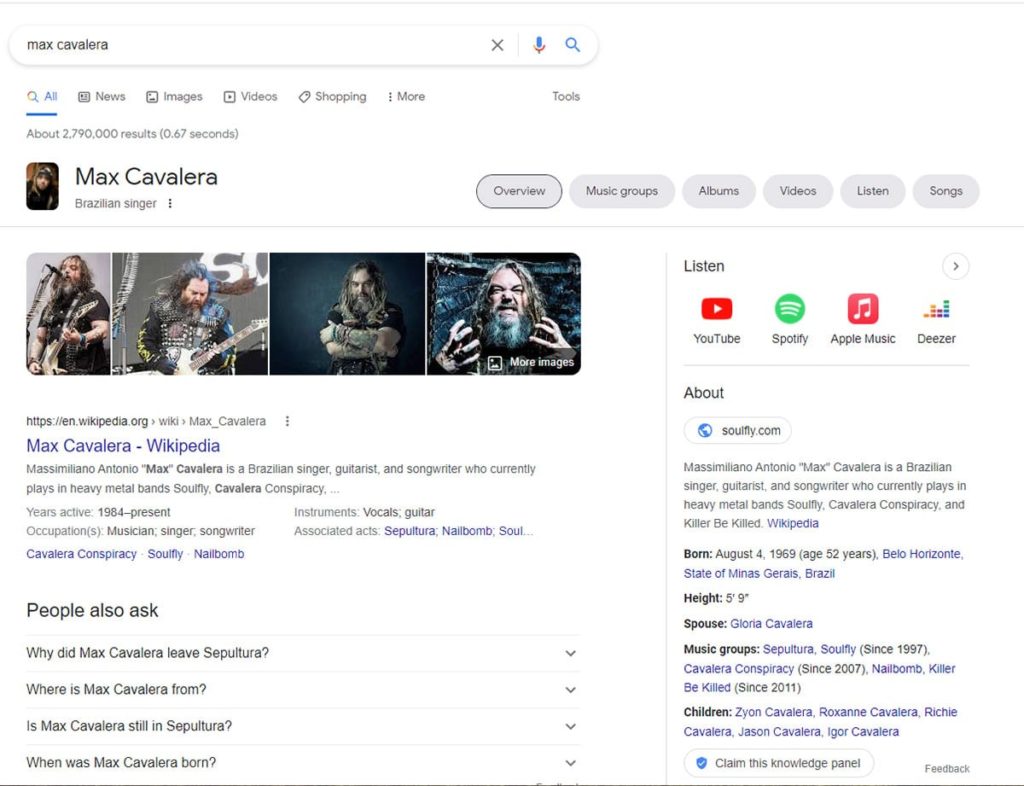
Source: Google.com – Search for Max Cavalera – \mm/
If your schema is properly set up, assuming your content is good, your authors and possibly your company could appear like this in the knowledge panels. This builds trust and shows authority and expertise to the user. It’s an enhanced listing that gives you extra credibility.
Check Schema.org for all the different types of schema you can use. Schema also helps reduce ambiguity among entities. For example, if your name is Michael Jackson, you would want to add a “sameAs” tag with a LinkedIn link to show that you are not the pop singer, but the guy who works at ABC company.
More schema is generally better if it is properly verified and relevant.
“Structured data adds a level of preciseness that a search engine needs, and might not grasp, because it doesn’t have the common sense of a human.” Bill Slawski, Director of Search Marketing, Go Fish Digital
Some examples of schema could be…
Person Schema Examples
- affiliation
- alumniOf
- award
- hasCredential
- hasOccupation
- jobTitle
- sameAs
This is the schema for an individual author or member of your staff. For blog posts and the like, you would use…
Article Schema Examples
- Author (person or org)
- ReviewedBy
- Citations (in the article or post)
- ArticleBody
- ArticleSection
- Audience
- Contributor (2nd author)
There are many types of schema. It is enerally written using a coding language called JSON.
JSON Schema Example
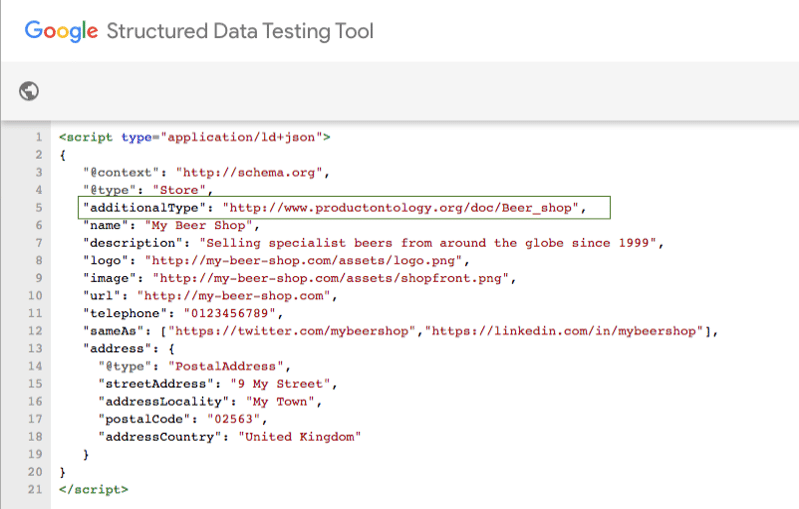
Source: SEMRush.com
Nested schema is best in that it adds more layers of information that is valuable to Google and the user. Lily Ray, an E-A-T expert, and Wellspring Digital Chat alum, has a great example of this…
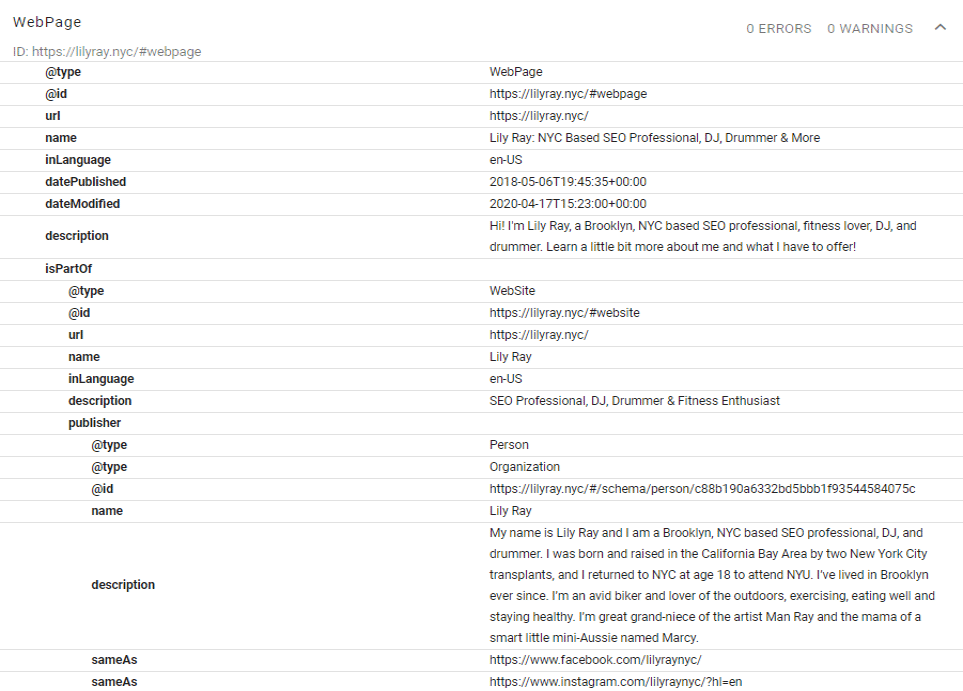
To see if you have this type of schema on a page of your website, go to https://validator.schema.org/ and enter the page URL. It will look something like this…
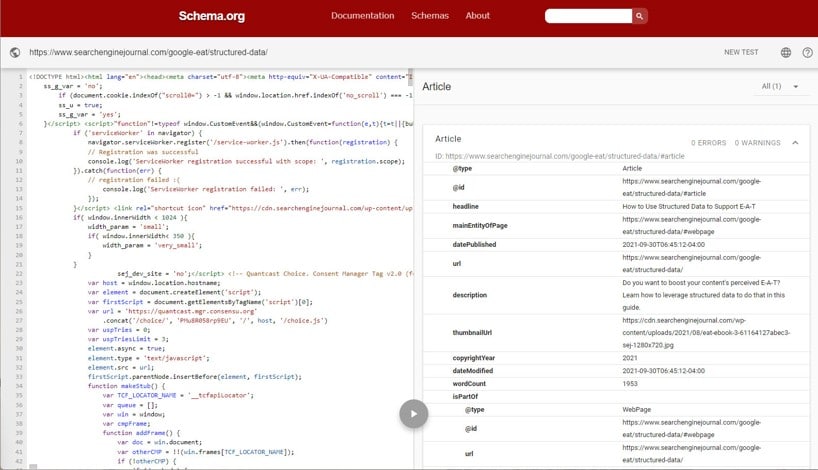
Source: Schema.org
At this point, you might be saying, “but Jon, I don’t know how to code in JSON to write schema for my website.” Well, maybe you weren’t saying that. But, nevertheless, there are lots of tools that make this super easy for you.
Schema Plugins for WordPress
Yoast is one of the most popular SEO tools available. Their tool is super easy to use and looks like this…
Yoast SEO Schema Enhancements
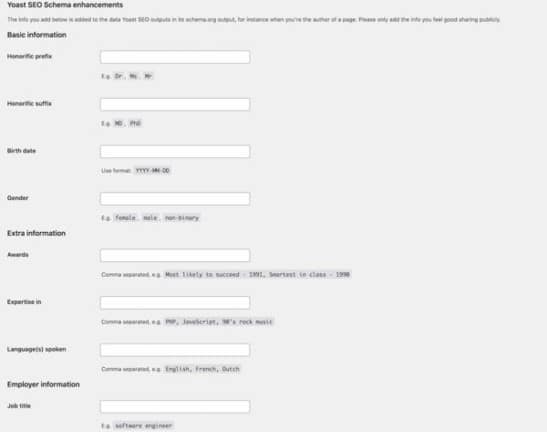
Source: Yoast.com
Here are some other schema tools…
Schema Tools
- Schema Pro
- All in One Schema Rich Snippets
- WP Review Plugin
- WPSSO Core
- WP SEO Structured Data Schema
E-A-T Is Your SEO Future!
Targeting E-A-T for your website and content is the best way to future-proof your SEO efforts. E-A-T is literally what the raters use to judge if Google is working properly or not. If you score high for E-A-T factors, you know that your website will perform well in the future.
E-A-T “Signals”
“It’s almost like we look for signals that align with expertise, authoritativeness, and trustworthiness. We should give that an acronym like E-A-T and maybe suggest people aim for this. Oh wait, we did.” Danny Sullivan, Google’s Public Search Liaison
So, why does E-A-T matter?
- There are “trust” based ranking signals in the algorithms now and they will grow in importance in the future.
- E-A-T signals if a site is “rank-worthy.”
- Your website’s E-A-T is now its brand online. This is how Google is going to judge your brand today and in the future.
- Websites with E-A-T get links and sales!
- A high E-A-T improves your ranking chances now and in the future.
Don’t Believe Me, Listen to the Experts!
Here are two well-respected and veteran SEOs who agree that E-A-T matters a great deal…
“Having a website doesn’t necessarily mean you deserve to rank. If there’s better, more authoritative content out there, then Google will, quite rightly, try to send traffic their way, not yours.” Joshua Hardwick, Founder of The SEO Project
And our fearless leader and 20+ SEO veteran, Karl Hindle…
“E-A-T is what sets you apart. E-A-T is what gets you long-term gains in SEO and wins the trust and business of your audience.” Karl Hindle, CEO of Wellspring Digital, Two Time US Search Award Judge
If you’ve made it through this monster post, then you can now say that you know what E-A-T is and why it matters. You are now armed with the information you need to make your argument to your boss that E-A-T matters!
Good luck and get that tasty E-A-T content out there! Do you need help with your SEO, content, or social media? Give us a shout!
 Jon-Mikel Bailey is CDMO at Wellspring Digital, LLC, a full-service digital marketing agency based in the Mid-Atlantic region serving clients nationwide. Jon is a speaker and writer about #MarketingAutomation, #SEO, #SocialMedia, #ContentMarketing, and more. Get more information at Wellspring Digital or follow Jon on Twitter.
Jon-Mikel Bailey is CDMO at Wellspring Digital, LLC, a full-service digital marketing agency based in the Mid-Atlantic region serving clients nationwide. Jon is a speaker and writer about #MarketingAutomation, #SEO, #SocialMedia, #ContentMarketing, and more. Get more information at Wellspring Digital or follow Jon on Twitter.
This article is reprinted by permission and first appeared on the Wellspring Digital website.
Frederick Chamber Insights is a news outlet of the Frederick County Chamber of Commerce. For more information about membership, programs and initiatives, please visit our website.
